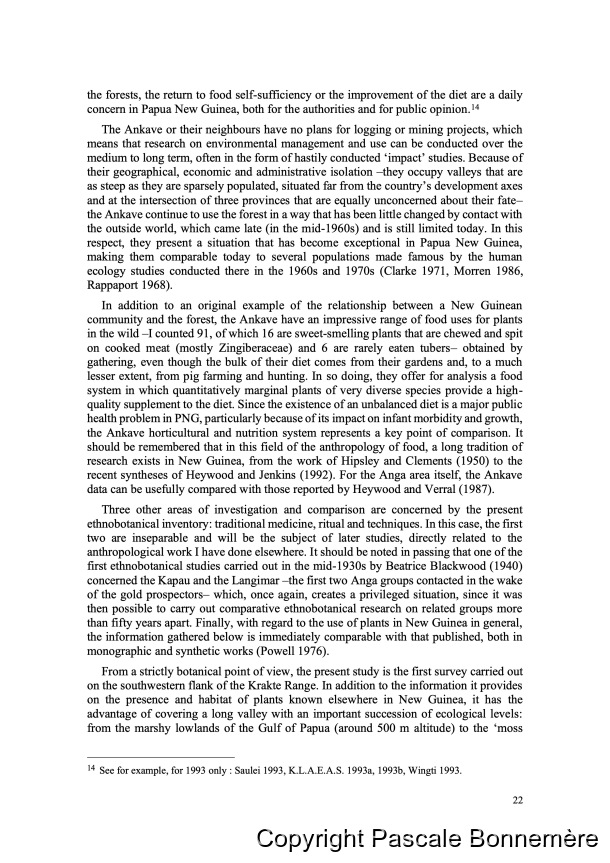|
|  [Note: this transcription was produced by an automatic OCR engine]
the forests, the return to food self-sufficiency or the improvement of the diet are a daily
concern in Papua New Guinea, both for the authorities and for public opinion. !4
The Ankave or their neighbours have no plans for logging or mining projects, which
means that research on environmental management and use can be conducted over the
medium to long term, often in the form of hastily conducted ‘impact’ studies. Because of
their geographical, economic and administrative isolation —they occupy valleys that are
as steep as they are sparsely populated, situated far from the country’s development axes
and at the intersection of three provinces that are equally unconcerned about their fate—
the Ankave continue to use the forest in a way that has been little changed by contact with
the outside world, which came late (in the mid-1960s) and is still limited today. In this
respect, they present a situation that has become exceptional in Papua New Guinea,
making them comparable today to several populations made famous by the human
ecology studies conducted there in the 1960s and 1970s (Clarke 1971, Morren 1986,
Rappaport 1968).
In addition to an original example of the relationship between a New Guinean
community and the forest, the Ankave have an impressive range of food uses for plants
in the wild -I counted 91, of which 16 are sweet-smelling plants that are chewed and spit
on cooked meat (mostly Zingiberaceae) and 6 are rarely eaten tubers— obtained by
gathering, even though the bulk of their diet comes from their gardens and, to a much
lesser extent, from pig farming and hunting. In so doing, they offer for analysis a food
system in which quantitatively marginal plants of very diverse species provide a high-
quality supplement to the diet. Since the existence of an unbalanced diet is a major public
health problem in PNG, particularly because of its impact on infant morbidity and growth,
the Ankave horticultural and nutrition system represents a key point of comparison. It
should be remembered that in this field of the anthropology of food, a long tradition of
research exists in New Guinea, from the work of Hipsley and Clements (1950) to the
recent syntheses of Heywood and Jenkins (1992). For the Anga area itself, the Ankave
data can be usefully compared with those reported by Heywood and Verral (1987).
Three other areas of investigation and comparison are concerned by the present
ethnobotanical inventory: traditional medicine, ritual and techniques. In this case, the first
two are inseparable and will be the subject of later studies, directly related to the
anthropological work I have done elsewhere. It should be noted in passing that one of the
first ethnobotanical studies carried out in the mid-1930s by Beatrice Blackwood (1940)
concerned the Kapau and the Langimar —the first two Anga groups contacted in the wake
of the gold prospectors- which, once again, creates a privileged situation, since it was
then possible to carry out comparative ethnobotanical research on related groups more
than fifty years apart. Finally, with regard to the use of plants in New Guinea in general,
the information gathered below is immediately comparable with that published, both in
monographic and synthetic works (Powell 1976).
From a strictly botanical point of view, the present study is the first survey carried out
on the southwestern flank of the Krakte Range. In addition to the information it provides
on the presence and habitat of plants known elsewhere in New Guinea, it has the
advantage of covering a long valley with an important succession of ecological levels:
from the marshy lowlands of the Gulf of Papua (around 500 m altitude) to the ‘moss
14 See for example, for 1993 only : Saulei 1993, K.L.A.E.A.S. 1993a, 1993b, Wingti 1993.
22
�
|